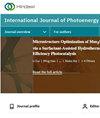常压空间原子层沉积法生长TiO2层的控制结晶度及其对钙钛矿太阳能电池效率的影响
IF 2.1
4区 工程技术
Q3 CHEMISTRY, PHYSICAL
引用次数: 0
摘要
大气压空间原子层沉积(AP-SALD)是一种即将到来的沉积技术,适用于各种材料,它结合了常规原子层沉积的优点和在环境条件下显著增加的沉积速率。在这项工作中,通过系统地改变工艺条件,如温度、反应物(H2O和O3)和后处理,用AP-SALD制备了非晶型和锐钛型TiO2层。所形成的层以其结构和光电子特性为特征,并用作混合钙钛矿太阳能电池中的空穴阻挡层。研究发现,在较高的沉积温度下制备的TiO2层具有较强的锐钛矿性质,但与钙钛矿层形成不利的界面,促进了复合,降低了太阳能电池的分流电阻和开路电压。因此,界面是有效萃取电荷的关键,通过控制工艺参数可以显著提高萃取效率。本文章由计算机程序翻译,如有差异,请以英文原文为准。
Controlled Crystallinity of TiO2 Layers Grown by Atmospheric Pressure Spatial Atomic Layer Deposition and their Impact on Perovskite Solar Cell Efficiency
Atmospheric Pressure Spatial Atomic Layer Deposition (AP-SALD) is an upcoming deposition technique suitable for a variety of materials and combines the benefits of a regular atomic layer deposition with a significantly increased deposition rate at ambient conditions. In this work, amorphous and anatase TiO2 layers are fabricated by AP-SALD via systematic variation of process conditions such as temperature, reactant (H2O and O3), and posttreatment. The formed layers are characterized for their structural and optoelectronic properties and utilized as a hole-blocking layer in hybrid perovskite solar cells. It is found that TiO2 layers fabricated at elevated deposition temperatures possess strong anatase character but expose an unfavorable interface to the perovskite layer, promoting recombination and lowering the shunt resistance and open circuit voltage of the solar cells. Therefore, the interface is essential for efficient charge extraction, which can be significantly improved by controlling the process parameters.
求助全文
通过发布文献求助,成功后即可免费获取论文全文。
去求助
来源期刊
CiteScore
6.00
自引率
3.10%
发文量
128
审稿时长
3.6 months
期刊介绍:
International Journal of Photoenergy is a peer-reviewed, open access journal that publishes original research articles as well as review articles in all areas of photoenergy. The journal consolidates research activities in photochemistry and solar energy utilization into a single and unique forum for discussing and sharing knowledge.
The journal covers the following topics and applications:
- Photocatalysis
- Photostability and Toxicity of Drugs and UV-Photoprotection
- Solar Energy
- Artificial Light Harvesting Systems
- Photomedicine
- Photo Nanosystems
- Nano Tools for Solar Energy and Photochemistry
- Solar Chemistry
- Photochromism
- Organic Light-Emitting Diodes
- PV Systems
- Nano Structured Solar Cells

 求助内容:
求助内容: 应助结果提醒方式:
应助结果提醒方式:


